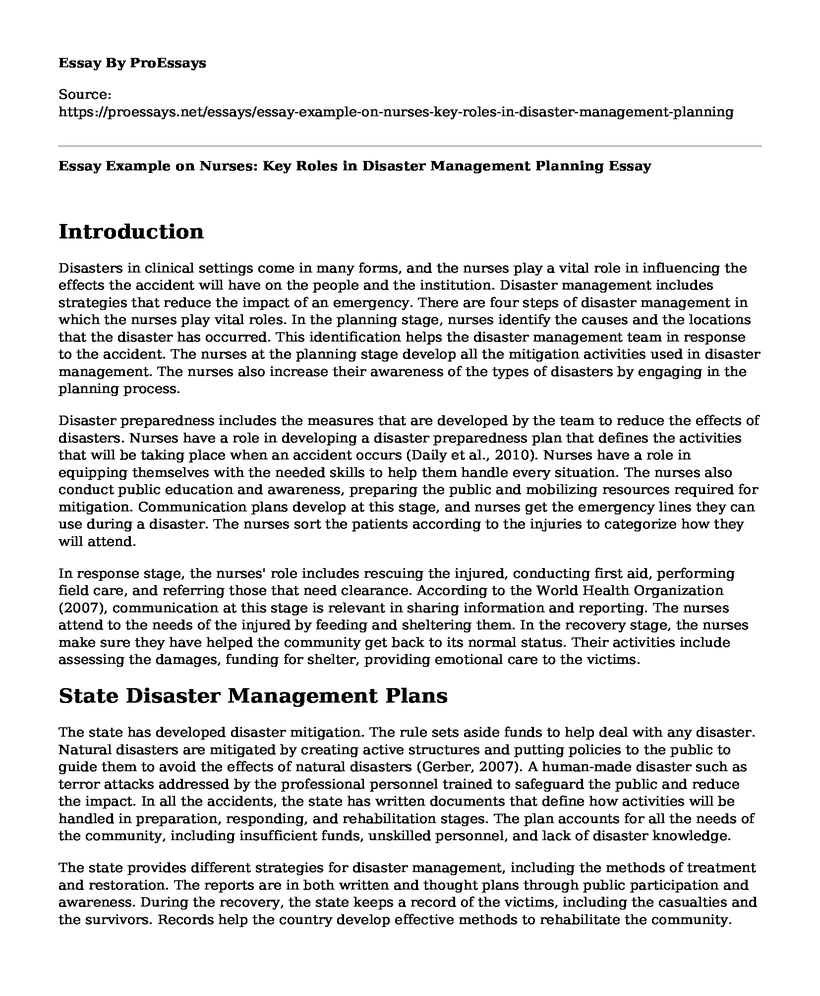Introduction
Disasters in clinical settings come in many forms, and the nurses play a vital role in influencing the effects the accident will have on the people and the institution. Disaster management includes strategies that reduce the impact of an emergency. There are four steps of disaster management in which the nurses play vital roles. In the planning stage, nurses identify the causes and the locations that the disaster has occurred. This identification helps the disaster management team in response to the accident. The nurses at the planning stage develop all the mitigation activities used in disaster management. The nurses also increase their awareness of the types of disasters by engaging in the planning process.
Disaster preparedness includes the measures that are developed by the team to reduce the effects of disasters. Nurses have a role in developing a disaster preparedness plan that defines the activities that will be taking place when an accident occurs (Daily et al., 2010). Nurses have a role in equipping themselves with the needed skills to help them handle every situation. The nurses also conduct public education and awareness, preparing the public and mobilizing resources required for mitigation. Communication plans develop at this stage, and nurses get the emergency lines they can use during a disaster. The nurses sort the patients according to the injuries to categorize how they will attend.
In response stage, the nurses' role includes rescuing the injured, conducting first aid, performing field care, and referring those that need clearance. According to the World Health Organization (2007), communication at this stage is relevant in sharing information and reporting. The nurses attend to the needs of the injured by feeding and sheltering them. In the recovery stage, the nurses make sure they have helped the community get back to its normal status. Their activities include assessing the damages, funding for shelter, providing emotional care to the victims.
State Disaster Management Plans
The state has developed disaster mitigation. The rule sets aside funds to help deal with any disaster. Natural disasters are mitigated by creating active structures and putting policies to the public to guide them to avoid the effects of natural disasters (Gerber, 2007). A human-made disaster such as terror attacks addressed by the professional personnel trained to safeguard the public and reduce the impact. In all the accidents, the state has written documents that define how activities will be handled in preparation, responding, and rehabilitation stages. The plan accounts for all the needs of the community, including insufficient funds, unskilled personnel, and lack of disaster knowledge.
The state provides different strategies for disaster management, including the methods of treatment and restoration. The reports are in both written and thought plans through public participation and awareness. During the recovery, the state keeps a record of the victims, including the casualties and the survivors. Records help the country develop effective methods to rehabilitate the community. Record-keeping systems continued to provide references and to create future strategies to reduce the effects of the disaster.
Casualties Management
The state has management plans for the casualties at the national community and hospital level. At the state level, the country has developed the mass casualty management plan and guidelines for monitoring the victims through financial and material resources (Cooper, 2006). At the community level, the state has developed management of mass fatalities plans and communication plans. At the hospital level, the country has training programs and emergency and trauma care systems to help the hospitals effectively attend to casualties.
References
Cooper, D. (2006). Mass casualty management in disasters. WHO: Health Action in Crisis. Geneva: World Health Organization. https://www.who.int/hac/events/experts2006/D_Cooper_Mass_casualth_disasters.pdf
Daily, E., Padjen, P., & Birnbaum, M. (2010). A review of competencies developed for disaster healthcare providers: limitations of current processes and applicability. Prehospital and disaster medicine, 25(5), 387-395. https://www.cambridge.org/core/journals/prehospital-and-disaster-medicine/article/assessment-of-community-healthcare-services-delivery-during-operation-cast-leada-cross-sectional-survey/3260E2744F429C7E4A18AB6EE979F437
Gerber, B. J. (2007). Disaster management in the United States: Examining key political and policy challenges. Policy Studies Journal, 35(2), 227-238. https://www.researchgate.net/publication/41373893_Disaster_Management_in_the_United_States_Examining_Key_Political_and_Policy_Challenges
World Health Organization. (2007). Mass casualty management systems: strategies and guidelines for building health sector capacity. https://www.who.int/hac/techguidance/tools/mcm_guidelines_en.pdf
Cite this page
Essay Example on Nurses: Key Roles in Disaster Management Planning. (2023, May 23). Retrieved from https://proessays.net/essays/essay-example-on-nurses-key-roles-in-disaster-management-planning
If you are the original author of this essay and no longer wish to have it published on the ProEssays website, please click below to request its removal:
- Ethics in Heathcare Essay Example
- Essay Sample on Diabetes Mellitus Type 2
- Research Paper on Alzheimer's Disease: 3.65M Affected in US, Projected to Grow to 5.7M by 2060
- Essay on 33% Assault on Native American Women: Unreported Deaths
- Essay Example on Maintain Ideal BMI for Health: 3 Strategies
- Joint Commission Accreditation: Strengthening Patient Safety & Organizational Growth - Essay Sample
- Paper Example on Enhancing Interpersonal and Communication Skills: My Work History







